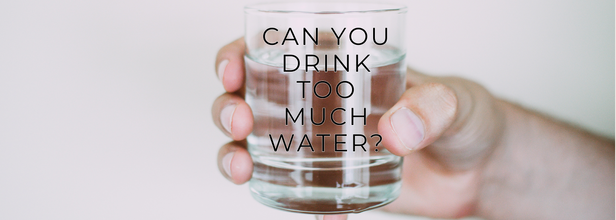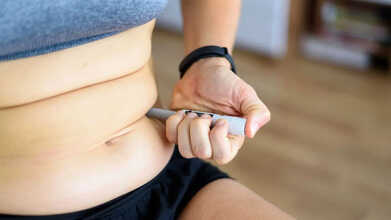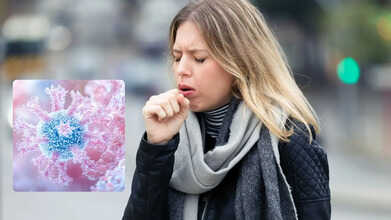- Health Conditions A-Z
- Health & Wellness
- Nutrition
- Fitness
- Health News
- Ayurveda
- Videos
- Medicine A-Z
- Parenting
Can You Drink Too Much Water?

Image Credit: Canva
From controlling body temperature and flushing out toxins, adequate hydration plays a vital role in our general health and well-being, water is a life essential. However, while dehydration garners significant attention, overhydration, or drinking excessive amounts of water, is a condition that can have serious and sometimes fatal consequences.
Although it may sound bizarre since drinking water is said to be the solution for most health related problems it is important to recognize how much water is considered "too much" or the risks involved with being overhydrated can maintain a healthy balance.
What Is Water Intoxication?
Water intoxication, also termed hyperhydration, water poisoning or water toxemia, develops when an individual drinks much more water than the kidney can excrete. The main function of the kidneys in the human body is the processing and excretion of excess water. However, the human kidneys can process only up to 0.8 to 1.0 liters of water at a time. Drinking an amount that exceeds this may overwhelm the kidneys and put the electrolyte balance out of sync in the human body.
Electrolytes, especially sodium, are essential in maintaining fluid balance within and outside cells. Hyponatremia is the condition when sodium levels fall below 135 mmol/L, resulting from excessive water intake. This causes water to shift into cells, swelling them. In the brain, this can cause severe complications, including coma or even death.
Symptoms of Water Intoxication
The symptoms of water intoxication vary from mild to severe. Early symptoms are often similar to dehydration, which makes self-diagnosis challenging. Common symptoms include:
- Headaches
- Nausea and vomiting
- Muscle cramps or weakness
- Fatigue or drowsiness
- Confusion and disorientation
In more serious cases, water intoxication can cause seizures, loss of consciousness, or swelling in the brain. These complications can be fatal if left untreated.
A notable case occurred in 2007 when a woman participating in a water-drinking contest tragically died after consuming nearly two gallons of water in under two hours. More recently, actress Brooke Shields experienced a grand mal seizure attributed to excessive water consumption.
Causes of Water Intoxication
Water intoxication is rare, but certain scenarios can increase the risk:
1. Sporting Events and Endurance Training
These endurance athletes are prone to water intoxication, especially if they drink large amounts of water without replacing lost electrolytes. Hyponatremia usually happens during long races or marathons as individuals mistake fatigue and muscle cramps for dehydration and continue drinking water in excess.
2. Military Training
Overhydration among military personnel is usually due to severe physical activity in extreme environmental conditions. The total number of hyponatremia cases documented from 2007 through 2022 for the active duty in the United States exceeds 1,600, with a note to this problem on exertion-related overhydration.
3. Mental Health Conditions
Compulsive water drinking, known as psychogenic polydipsia, is linked with some mental illnesses such as schizophrenia and psychosis. People with these conditions tend to drink too much water, causing a hazardous electrolyte imbalance.
4. Drug Abuse
Drugs such as MDMA (ecstasy) raise the body temperature and make people thirsty, and at times, some people tend to drink excess water at events like music festivals. MDMA also leads to urine retention, thus exacerbating the dangers of water intoxication.
How Much Water Is Too Much?
The exact amount of water that causes intoxication varies from one person to another. However, drinking more than 1 liter of water per hour for several hours raises the risk. For healthy individuals, the risk of overhydration is low unless taking part in extreme physical activity or ignoring thirst cues.
Certain medical conditions, such as kidney or liver disorders, can impair the body's ability to process fluids, and even moderate water intake may be harmful. Similarly, certain medications, such as diuretics and antipsychotics, can affect the perception of thirst or fluid regulation.
How Much Water Is Enough?
The widely touted recommendation of eight 8-ounce glasses of water per day has little basis in fact. According to the National Academy of Medicine, a daily total fluid intake is about 15 cups (3.7 liters) for males and 11 cups (2.7 liters) for females, from beverage sources and from food. Usually, about 20 percent of daily hydration comes from foods such as fruits and vegetables.
A better rule of thumb is to listen to your body and drink water based on thirst. Use the color of your urine as an indicator:
- Light yellow urine indicates proper hydration.
- Dark yellow urine may indicate dehydration.
Older adults, whose thirst mechanisms may decline with age, should be proactive about maintaining hydration, especially during illness or hot weather.
Water Intoxication vs. Dehydration
The symptoms of water intoxication—such as headaches, fatigue, and muscle weakness—are similar to those of dehydration. If you are unsure which condition you are experiencing, seek medical attention immediately rather than self-treating with more water.
Preventing Water Intoxication
To avoid the dangers of overhydration:
- Drink water gradually throughout the day rather than consuming large amounts at once.
- Replace lost electrolytes post high-intensity exercise or heavy sweating.
- Consider using sports drinks or salty snacks to help replenish sodium.
- Keep track of fluid consumption during long-duration activities, and do not consume more water than the body is losing in terms of electrolytes.
- If on medications or have specific medical conditions, check with your doctor regarding the safety of drinking water.
For signs of severe water intoxication-including confusion, drowsiness, seizures, and loss of consciousness-customer is advised to seek medical assistance immediately. In the meanwhile, a salty snack would help to temporarily correct low sodium levels.
Hydration is important to health, but overhydration can be a serious risk; the secret is in finding a balance. Drink enough water to satisfy your body, but not so much that it overwhelms your system. Remember, water is life, but moderation keeps it that way.
Hyponatremia (low sodium level in the blood). National Kidney Foundation. 2023.
Water Toxicity. NIH. 2023
Exercise-Associated Hyponatremia: 2017 Update. Front Med (Lausanne). 2017
Update: Exertional Hyponatremia Among Active Component Members of the U.S. Armed Forces, 2007–2022
Weight Loss Jabs: What Happens To Your Body When You Stop Taking Them?

Credits: Canva
Weight-loss jabs, or GLP-1 receptor agonists, have provided many people with results that diets alone could not achieve. For those struggling with constant cravings, these medications have quieted the persistent “food noise” that often drives overeating. They have transformed not only body shapes but also self-confidence and daily habits.
Yet questions remain: can people safely stop taking these drugs, and what happens to the body when they do? These are still largely unknown, as the drugs are relatively new. GLP-1s mimic a natural hormone that controls hunger, but the long-term effects are only beginning to be understood. Additionally, for the estimated 1.5 million people in the UK paying privately for these injections, maintaining treatment can be costly.
Two women, Tanya and Ellen, share their personal experiences with the BBC on weight-loss jabs and what life was like when they attempted to stop.
Weight Loss Jabs: Tanya Hall’s Experience
Tanya, a sales manager in the fitness industry, initially started taking Wegovy to challenge her own perceptions about weight and authority. She often felt overlooked or undervalued because of her size, and hoped that losing weight would change how others treated her, as per BBC.
Early in treatment, Tanya experienced side effects including nausea, headaches, sleep issues, and hair loss, which she describes as clumps coming out. Despite this, she steadily lost weight—six stone (38 kg) over 18 months—and the injections quieted the relentless urge to eat.
However, every time she tried to stop, her appetite surged within days, leaving her horrified at her own eating. Now, Tanya continues the medication, feeling it has become essential to maintaining her weight and the confidence it brings.
Weight Loss Jabs: What Happens To Your Body When You Stop Taking Them?
Wegovy’s manufacturer, Novo Nordisk, stresses that treatment decisions should be made with medical guidance and that side effects must be considered. Lifestyle GP Dr. Hussain Al-Zubaidi likens stopping GLP-1s abruptly to being hit by a “tsunami” of hunger.
Research shows that within one to three years of stopping these medications, people can regain 60–80% of the weight they lost. This highlights how these drugs work not just by reducing appetite temporarily but by fundamentally altering hunger cues.
Weight Loss Jabs: Ellen Ogley’s Journey
Ellen turned to Mounjaro after reaching a critical point in her life. Her weight had put her at risk during surgery, and emotional binge eating dominated her daily habits. Once on the medication, Ellen noticed her compulsive eating completely stopped.
Over 16 weeks, she lost 3 st 7 lb (22 kg) and began tapering off the injections over six weeks. She focused on developing a healthier relationship with food, creating balanced meals, and incorporating exercise into her routine. Despite some weight creep after stopping, she has since lost a total of 51 kg and now feels confident her habits are sustainable.
Weight Loss Jabs: The Importance of Support
Dr. Al-Zubaidi emphasizes that exiting GLP-1 treatment safely requires guidance and long-term support. NICE recommends at least a year of tailored advice after stopping injections to help individuals maintain their weight and prevent relapse, as per BBC.
For patients paying privately, such structured support may not always be available, increasing the risk of regaining weight. Lifestyle, mindset, and environmental factors play a significant role in long-term outcomes.
Tanya has chosen to continue with her medication, aware of the pros and cons, while Ellen has closed that chapter and built a sustainable routine for life after Mounjaro.
Weight-loss jabs can dramatically change appetite and body weight, but stopping them can be challenging. The transition off these drugs requires careful planning, support, and lifestyle adjustments. As Tanya and Ellen’s experiences show, the journey varies by individual, and long-term strategies are essential to maintaining health and weight loss results.
Eli Lilly, the manufacturer of Mounjaro, states that patient safety is its top priority and that it continually monitors and reports information on treatment outcomes to regulators and prescribers.
Flu Cases Surge Across The US: How Long Does The Super Flu Remain Contagious?

Credits: Canva
Flu Symptoms: Seasonal infections are spreading across the United States just as the holiday travel rush gets underway, worrying health officials about fresh spikes during family get-togethers. Flu and norovirus cases are rising in several states, while COVID-19 continues to circulate at lower but consistent levels. Together, these illnesses are adding strain on hospitals as millions of people plan to travel in the days ahead.
Flu: What Is Super Flu?
“Super flu” is not a clinical term, but it is often used to describe a flu season that feels more aggressive or spreads faster than usual. This is typically linked to a dominant strain of influenza A. The current surge is being driven by a mutated influenza A strain known as H3N2 subclade K. Health officials say this strain has become the leading flu variant in the US, accounting for roughly 89 percent of H3N2 samples analysed since late September, according to genetic sequencing data from the Centers for Disease Control and Prevention (CDC).
This variant emerged after the 2025–26 flu vaccine was formulated, meaning the vaccine may not be as closely matched as in earlier seasons. While the shot still offers protection against severe disease, experts note that the mismatch could allow the virus to spread more easily.
Flu Symptoms 2025: What Symptoms Should People Watch For?
The symptoms seen in the current flu wave are largely familiar. People may develop fever, chills, extreme tiredness, cough, and body aches. Doctors, however, caution that the wider spread could result in more serious cases, particularly among people who are at higher risk.
CDC estimates indicate that the US has already seen about 4.6 million flu cases this season, along with nearly 49,000 hospital admissions and around 1,900 deaths. Flu activity increased sharply in mid-December, with test positivity jumping from 8.1 percent to 14.3 percent within a single week.
Flu Symptoms 2025: How To Reduce The Risk
Doctors recommend staying home when feeling unwell, washing hands often, especially to limit norovirus spread, and considering vaccination against flu and COVID-19. Even when the strain match is not ideal, experts stress that vaccines remain crucial in reducing the risk of severe illness, hospitalisation, and death.
Flu Cases In The US: How Contagious Is Superflu?
In terms of how easily it spreads, it behaves much like regular flu, which is known to be highly contagious.
Someone with flu can pass on the virus from around one day before symptoms appear and continue to be contagious for five to seven days after becoming sick. Children, older adults, and those with weakened immune systems may remain infectious for a longer period.
The virus mainly spreads through respiratory droplets released when an infected person coughs, sneezes, speaks, or breathes near others. It can also spread through contact with contaminated surfaces, followed by touching the mouth, nose, or eyes. Crowded indoor settings, poor airflow, and close contact make transmission far more likely, which explains why flu spreads quickly during peak season.
What makes a so-called “super flu” seem more contagious is not a new way of spreading, but higher case numbers, quicker community transmission, and stronger symptoms, all of which increase coughing, fever, and the amount of virus released.
These 3 Persistent Changes In Your Feet May Be A Sign Of High Cholesterol

Credits: Canva
Raised cholesterol levels do more than strain the heart. They can sharply limit blood circulation to the arms and legs, increasing the risk of serious health problems. High cholesterol is already known to raise the chances of heart attacks and strokes, which makes recognising early warning signs especially important.
Low-density lipoprotein, commonly known as LDL or “bad” cholesterol, builds up along artery walls. Over time, this build-up narrows the blood vessels and increases the likelihood of blockages that can lead to cardiac arrest. According to the NHS, diets high in fatty foods, frequent alcohol intake, and a lack of physical activity are among the main reasons cholesterol levels rise.
Why Symptoms May Appear in the Feet
Although cholesterol is often detected through medical tests, warning signs can sometimes surface in unexpected parts of the body, including the feet. Paying attention to these changes can help doctors identify peripheral artery disease, or PAD, which develops when fatty deposits restrict blood flow. This has been reported by Surrey Live.
The British Heart Foundation explains that as circulation worsens, the body struggles to supply enough oxygen, nutrients, and blood to the skin and surrounding tissues. This problem is most noticeable in the feet, as they are the farthest point from the heart.
Three Serious Foot Symptoms Linked to High Cholesterol
There are three major signs of high cholesterol that may show up in the feet:
- Pain
- Ulcers
- Gangrene
Other PAD Symptoms to Look Out For
People with peripheral artery disease may also notice additional changes, such as:
* Loss of hair on the legs or feet
* Weakness or numbness in the legs
* Toenails that grow slowly or become brittle
* Open sores on the feet or legs that take a long time to heal
* Changes in skin colour, including pale or bluish tones
* Skin that looks shiny
* Erectile dysfunction in men
* Loss of muscle mass in the legs
Lowering cholesterol levels is essential to reduce the risk of PAD and other complications associated with high cholesterol.
It is important to confirm high cholesterol with a healthcare professional, as many people experience few or no symptoms.
A blood test remains the most reliable way to detect high cholesterol, which often goes unnoticed without screening.
When Symptoms Become an Emergency
Symptoms such as foot pain, ulcers, and gangrene may signal a severe form of PAD known as critical limb ischaemia. The British Heart Foundation warns that this condition needs urgent medical treatment to help prevent limb loss.
If a doctor suspects high cholesterol, the NHS advises that a blood test will usually be recommended.
How Cholesterol Is Tested
There are two main ways cholesterol levels can be checked:
* A blood sample taken from the arm
* A finger-prick test
If results confirm high cholesterol, a GP will talk through ways to bring levels down, which may include changes to diet or prescribed medication.
Diet Changes That Can Help
Adjusting what you eat is often one of the most effective ways to reduce cholesterol, as diet is a common cause of high levels. One practical step is to cut back on saturated fats and replace them with unsaturated fats.
Saturated fats are commonly found in foods such as fatty cuts of meat, butter, cheese, and lard. Unsaturated fats, on the other hand, are present in vegetables, nuts, seeds, and plant-based oils.
Apart from that, increasing physical activity can also help manage cholesterol and support overall heart health.
UK health guidelines recommend that adults aim for at least 150 minutes of moderate-intensity activity each week, or 75 minutes of vigorous exercise. Doing more activity, or increasing intensity, can reduce the total time needed. Moderate exercise means your heart rate rises and breathing becomes heavier, but you should still be able to talk without struggling for breath.
One practical way to reach the 150-minute target is to stay active for 30 minutes a day, on at least five days each week.
© 2024 Bennett, Coleman & Company Limited

